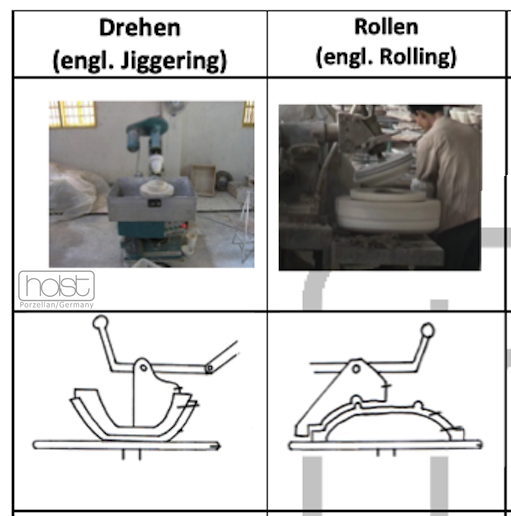Turning (Jiggering)
Turning (Jiggering) in porcelain production
When differentiating between the production techniques "jiggering" and "rolling" of ceramic products, one often and gladly finds overlaps or mix-ups, since both types of processes are operated by means of rotation. A distinction is made between two methods.
- Rolling (Over-Rolling / Exterior) - in which the mass is rolled over the mould
- Jiggering (Inside-Rolling / Interior) - in which the mass is rolled into a form
A further contribution is made by the fact that in the English language both techniques are called "rolling", since there is no difference in the choice of words between "turning" and "rolling". Both techniques, i.e. Exterior and Interior, work with a firmer mass, the "Hubel", which is placed on or in the mould as a cut disc. A rotating stamp then distributes the mass evenly over or in the mould. After a short drying time within a few minutes, the article can be removed from the mould.

This page deals with the "jiggering" of cups, mugs and other hollow parts such as bowls, bowls, bowls, etc. Basically, there are 2 traditional production methods for making hollow parts from ceramic materials:
- the casting - in one piece
- the jiggering - with a later handle attachment
The first fully automatic press lines are also already available, but we would like to deal here with the usual production methods.
Single and multi-station jiggerers
Small and inconspicuous, but nevertheless a performance giant - like its "plate colleague" - is the production of hollow parts on single-place jiggerers. If one did not have to place the handle on the cup body by hand, the production capacity of this small machine would be enormous. Up to 720 cup bodies can be produced per hour on a single single-station machine per hour in piecework. These relatively simple machines were replaced in Europe with increasing industrialization by cup machines or by so-called semi-automatic machines (cycle line, see below), which offer incredible capacities. However, the conversion of these machines is more complex, which is to the detriment of the variety of cups produced by many manufacturers. Holst Porzellan offers with our extensive collection of drinking cups and bowls hollow parts of all manufacturing methods, without the product itself betraying its manufacturing method.
Cup production - the single station (single station turner)
Jiggering in multi-part moulds
The production of conical cups or upwardly tapering hollow bodies of porcelain is particularly expensive and complex. Here the classic stamp jiggerer fails because of the rising shape of the porcelain body. In such cases a two-part mould is required! In other words: A coffee cup produced in this way, such as our Haferl, the grandma cup or the anti-sloshing mug Peter, causes twice the mould costs and twice the mould consumption as a cylindrical hollow body.
Following the same principle as the single jiggerer for cups, the "little brother" works as a stamp roller. It works with a lower rotational speed and thus a little slower than its big brother, but this gives it a special quality: porcelain bodies with a relief work better and more beautifully on it! This makes it especially popular for ramequin shapes and similar items. In Asia, there are a lot of family businesses that supply one or two stamp rollers and a small chamber kiln for large, well-known factories at low cost. So one person alone can ensure a good life for a whole family.
The production lines
In contrast to the single station roller, several cups of one form run on the "cup line" in semi-automatic production mode. On the so called "production lines" the moulds are mounted on a rotating disc or a conveyor belt similar construction. The porcelain mass (Hubelmass) is pressed into the moulds with a "stamp" or turned in. This production method is particularly suitable for cylindrical articles or porcelain containers that are conical at the top. By using this machine a high degree of precision is achieved and the quality of the final product is usually higher than that of the single roller. On the other hand, the basic costs in mould making are considerably higher and require a much larger number of porcelain articles to be produced.
